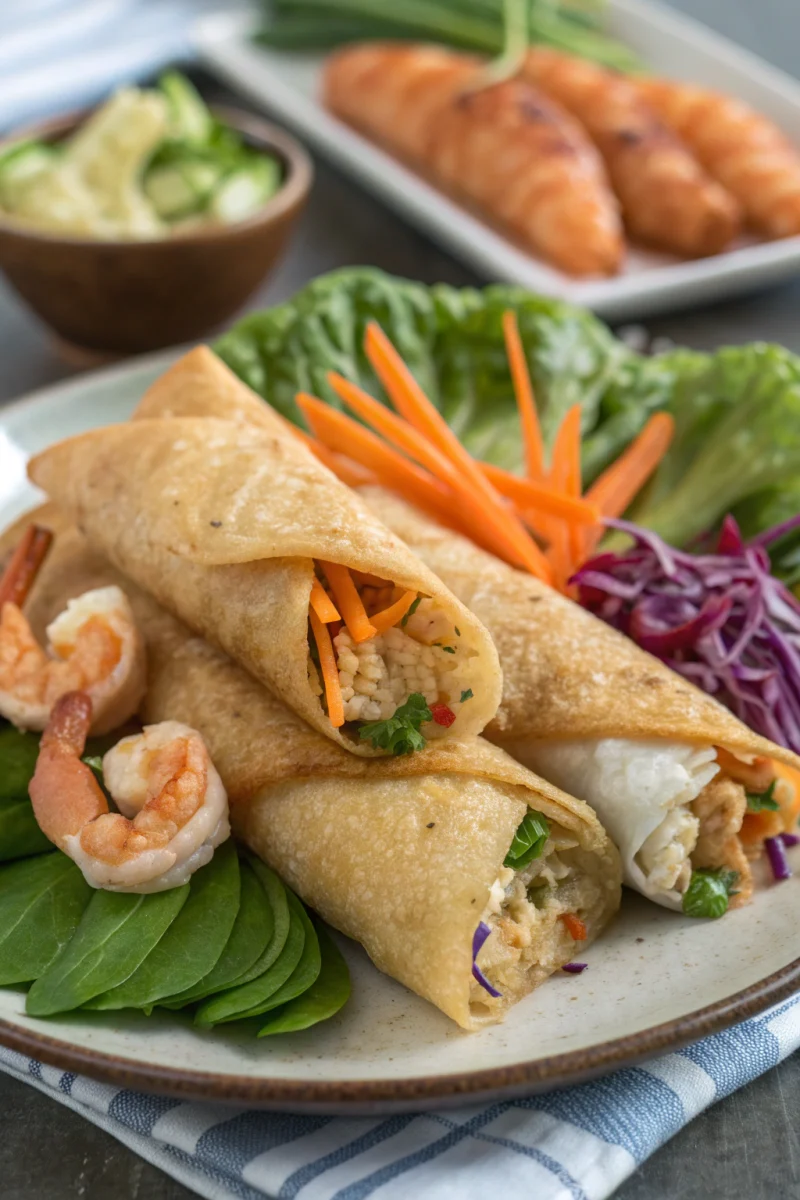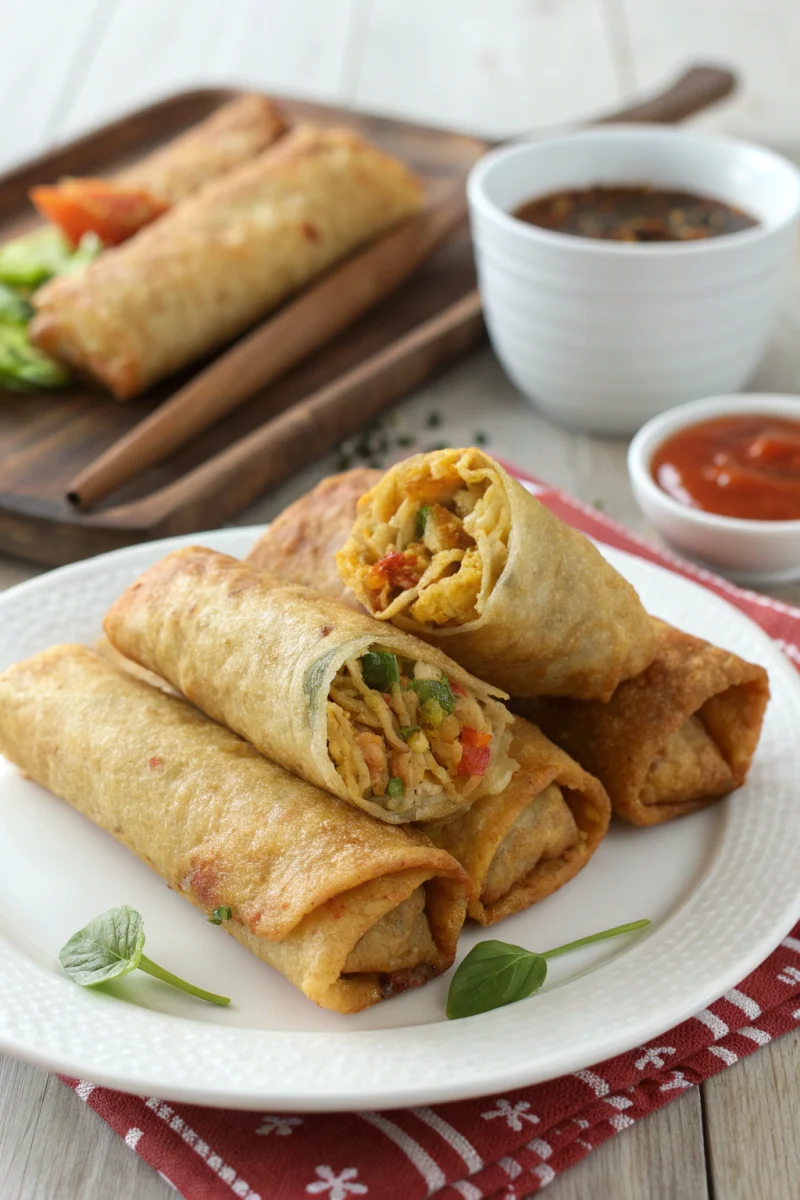Dosa Spring Rolls Recipe (Crispy Indian Fusion Snack)
Dosa Spring Rolls are a crisp, shareable Indian fusion snack: thin fermented dosa wrapped around spiced veggies, rolled tight, and sliced into irresistible bites—perfect for cozy autumn gatherings.

Introduction
Dosa is a beloved South Indian crepe made from a fermented batter of rice and lentils. It is thin, lacy, lightly tangy, and often eaten at breakfast with chutneys and a bowl of piping hot sambhar. Over the last decade, dosa has stepped beyond its traditional role and become a versatile canvas for creative cooks. One of the most exciting modern spins is the Dosa Spring Roll: a dosa sheet rolled tight around a flavorful, stir-fried filling, then sliced like classic spring rolls. The result is a snack with crisp edges, a tender bite, and a bright jumble of vegetables or proteins inside. It is playful, deeply satisfying, and surprisingly approachable in a home kitchen.
This guide walks you through everything you need to make Dosa Spring Rolls with confidence. We will cover the historical context that inspired this fusion, a detailed ingredient breakdown, step-by-step methods, common pitfalls and how to fix them, techniques for achieving maximum crispness with minimum oil, seasonal variations that suit an autumn table, storage and make-ahead strategies, plus serving ideas and pairing suggestions. Whether you are experienced with dosa or rolling it for the first time, you will find clear instructions and practical tips to help you succeed.
Why Dosa Spring Rolls Work
Classic spring rolls are adored for their crunchy shell and savory, textural filling. Dosa Spring Rolls honor that balance while adding the gentle tang of fermentation and the whisper-thin, shattering texture of a well-cooked dosa. Because dosas are naturally dairy-free and can be made fully gluten-free, they suit a wide range of eaters. The filling is endlessly modular: vegetables for freshness and crunch, spices for warmth, aromatics for complexity, and optional proteins to make it a meal. You can pan-crisp the rolls in a tablespoon of oil or use an air fryer for an even lighter result. Sliced into bite-size coins, they look striking on a platter and invite dipping, sharing, and repeat snacking.
Origins and Cultural Context
Dosa has deep roots in Southern India, with centuries of culinary history behind it. The batter is traditionally a mixture of soaked rice and urad dal (black gram) fermented until fluffy and aromatic. Masala dosa—dosa filled with spiced potatoes—proved that dosa and a hearty filling were a natural pairing. As India’s street-food and restaurant culture evolved, so did playful mashups: Indo-Chinese chilis met South Indian batters; stuffed dosas took on global flavors; and social media accelerated new forms. Rolling dosa into spring-roll form is a contemporary expression of this culinary curiosity. It does not pretend to be “authentic” in the classical sense; instead, it proudly celebrates how cuisines talk to one another while respecting the essentials that make dosa special: fermentation, finesse, and a hot griddle.
Ingredient Deep Dive
Dosa batter: The foundation. Well-fermented batter makes thin crepes that brown beautifully and remain pliable enough to roll. If the batter is under-fermented, dosas can taste flat and tear more easily; if over-fermented, they may taste too sour and spread poorly. A batter with a pourable, ribbon-like consistency is ideal.
Oil: Any neutral oil works for sautéing the filling and crisping the rolled dosa. Sesame oil (the light, untoasted kind) adds a subtle nuttiness; ghee offers richness and helps edges brown.
Aromatics: Ginger and garlic lend warmth and backbone. Green chilies add brightness and heat; scallions contribute freshness. These are quick-cooking flavors—keep the pan hot and the sizzle lively.
Vegetables: Cabbage, carrots, and bell peppers are popular because they retain crunch after a short stir-fry. Julienned or thinly shredded shapes stack neatly inside the roll. Mushrooms bring savoriness; bean sprouts add snap; leafy greens like spinach or kale wilt to a silky texture.
Seasonings and sauces: A small splash of soy sauce or tamari, black pepper, and a pinch of red chili flakes deliver umami and gentle fire without drowning the vegetables. A touch of rice vinegar or lime juice at the end can brighten the filling.
Protein options: Scrambled eggs, paneer, tofu, or fine shreds of cooked chicken integrate easily. Keep pieces small so the roll stays tight and sliceable.
Finishers: Fresh coriander (cilantro), toasted sesame seeds, or crushed roasted peanuts add pop and texture when the rolls are sliced and plated.
Texture and Structure: What Makes a Great Roll
A successful Dosa Spring Roll has three textures in harmony: a thin, crisp shell; a juicy-tender interior; and a clean, not-greasy finish. The dosa must be cooked enough to release from the pan and pick up a golden lace, yet remain pliant. The filling should be sautéed hot and fast, with excess moisture driven off to prevent sogginess. Rolling must be tight enough to hold together under the knife. Finally, a brief crisping—pan or air fryer—locks the shape and creates the “snap.”
Step-by-Step Method
1) Stir-fry the filling
Heat a wok or wide skillet over medium-high heat until lightly smoking. Add a tablespoon of oil, then ginger, garlic, and optional green chilies. Stir for 20 to 30 seconds until fragrant. Add cabbage, carrot, and bell pepper with a pinch of salt. Toss quickly; the goal is tender-crisp vegetables with edges just beginning to char. Splash in soy sauce or tamari and a few turns of black pepper. If using, fold in finely diced tofu, scrambled egg, or shredded chicken. Taste and adjust salt and heat. Spread the filling on a plate to cool—warm is fine, but avoid rolling with steaming-hot filling.
2) Cook the dosa sheets
Heat a nonstick tawa or well-seasoned cast-iron griddle over medium-high heat. When a drop of water skitters and evaporates instantly, it is ready. Ladle on batter and spread in quick circles from the center out, as thin as you comfortably can without causing gaps. Drizzle a few drops of oil at the edges. Cook until the surface turns matte and the rim lifts easily. You do not need to flip. Lift gently with a thin spatula and slide to a board. Make several sheets before you start rolling so assembly flows smoothly.
3) Roll snug and even
Place a dosa sheet on your board with the more golden side down (this will be the outside once rolled). Spoon a modest strip of filling—two to three tablespoons—along the nearest edge. Fold the left and right sides inward by about one centimeter to tuck the edges, then roll away from you, keeping even pressure with your fingertips. A tight cylinder prevents gaps and oozing.
4) Set the shape with heat
To “set” the roll, brush lightly with oil and place seam-side down in a hot skillet. Turn every 30 to 45 seconds until the exterior is evenly golden and crisp, two to three minutes total. Alternatively, mist with oil and air fry at 190°C for eight to ten minutes, turning once. Let the roll rest for a minute so the crust firms, then slice crosswise with a very sharp knife into two- or three-bite pieces.
5) Plate and serve
Arrange slices on a platter. Garnish with scallions, coriander, sesame seeds, or crushed peanuts. Offer a trio of dips for visual and flavor contrast—something creamy and cooling, something tangy, and something lightly sweet with heat.
Troubleshooting and Pro Tips
- Rolls tearing: The dosa sheet was too thin or the filling too wet. Cook the vegetables hotter and faster; let them steam off excess moisture. Spread batter slightly thicker next time.
- Soggy texture: Filling was rolled in while hot, or the pan was too cool when crisping the log. Cool the filling briefly and preheat pans properly.
- Chewy shell: Dosa was poured too thick. Aim for a crepe-like spread and keep your wrist loose as you spiral outward.
- Rolls unravelling: The initial seam wasn’t set. Always crisp seam-side down first so it seals.
- Uneven browning: Rotate the roll frequently and use a pan that heats evenly. Cast iron excels once preheated.
- Knife squashing the roll: Use a very sharp chef’s knife or serrated slicer and saw gently; avoid pressing straight down.
Filling Variations
Masala potato: A nod to masala dosa, with spiced, mashed potatoes, peas, mustard seeds, and curry leaves. Keep the mash slightly firm so it slices cleanly.
Paneer bell pepper: Small paneer cubes tossed with peppers, onions, and garam masala for a protein-forward roll.
Tofu and greens: Crumbled firm tofu with spinach or kale, ginger, and chili for a vegan option that feels hearty.
Mushroom-chili: Sliced mushrooms sautéed until deeply browned with garlic and crushed chili—rich, meaty flavors without meat.
Kimchi sesame: Drained, chopped kimchi with scallions and toasted sesame for a Korean-leaning bite.
Mediterranean roast veg: Roasted peppers, zucchini, and onions with a swipe of hummus inside the roll.
Tex-Mex bean and corn: Black beans, corn, and a hint of cumin, finished with lime. Keep moisture low so the roll stays crisp.
Seasonal Focus: Why They Shine in Autumn
Autumn vegetables like cabbage and carrots are abundant and inexpensive, and their natural sweetness blooms when cooked hot and fast. The spice profile—ginger, pepper, chili—gives warmth without being heavy. The rolls are perfect for gatherings: they can be assembled ahead and crisped to order; they suit a range of dietary preferences; and they look celebratory on a platter. Pair them with pumpkin or tomato chutney for an autumnal color story and serve alongside soups or stews when the evenings turn cool.
Nutrition Notes
Two to three pieces make a satisfying snack. The dosa batter’s fermentation can make it easier to digest than non-fermented counterparts. Because the dish is largely composed of vegetables and a very thin crepe, it naturally trends lighter than deep-fried spring rolls. Air frying or shallow pan-crisping keeps added fat in check. To increase protein, add paneer, tofu, or chicken. To increase fiber, double down on cabbage and add leafy greens or mushrooms. Sodium can be moderated by using low-sodium tamari or coconut aminos and seasoning more with aromatics and acids than salt.
Equipment Notes
A tawa (griddle) is traditional. Nonstick pans are forgiving for beginners, while cast iron gives beautiful browning once properly seasoned. A wide wok or sauté pan encourages fast evaporation so vegetables stay crisp. An air fryer gives hands-off crisping with minimal oil. Keep a thin, flexible spatula for lifting dosa without tearing, and use a very sharp knife for clean slices.
Make-Ahead, Storage, and Reheating
You can make the filling up to two days ahead; store it tightly covered in the refrigerator. Batter also keeps well and often improves after a night in the fridge. For batch prep, roll the dosa logs and refrigerate them uncooked for up to 48 hours, then crisp just before serving. Cooked rolls hold for about three days; re-crisp in a hot oven or air fryer so the shell snaps again. For longer storage, freeze uncrisped logs on a tray until firm, then pack into freezer bags. Cook from frozen, adding a few minutes to the time and turning often to prevent over-browning on one side.
Serving Ideas and Platters
On a party board, alternate slices of different fillings so guests can see the colors in cross-section—orange carrot, green scallion, pale tofu, golden potato. Offer three dips in small bowls and label them. Garnish with coriander and sesame seeds. For a sit-down starter, serve three pieces per person with a spoonful of chutney and a small salad of shaved cucumber and herbs. Dosa Spring Rolls also travel well for potlucks; bring them uncrisped and finish on-site in an oven or air fryer.
Beverage Pairings
Masala chai echoes the warmth of the spices; ginger tea refreshes between bites; lightly sparkling water with a squeeze of lime cleanses the palate. For an alcohol pairing, a crisp lager, wheat beer, or off-dry Riesling has the acidity and bubbles to cut through the richness of the roll’s exterior without overwhelming the delicate dosa flavor.
Step-by-Step Recap (Quick Reference)
- Stir-fry aromatics and vegetables hot and fast; season and cool.
- Cook thin, pliant dosa sheets on a hot griddle; do not flip.
- Roll tightly with modest filling; tuck sides to create an even cylinder.
- Crisp the log seam-side down first; rotate until evenly golden.
- Rest briefly, slice with a sharp knife, and plate with dips and garnishes.
Frequently Encountered Questions (General Concepts)
(Kept as part of the original raw body; structured FAQs will be added separately.)
Can I use leftover batter? Yes. If it has soured too much, balance with a touch of fresh batter before cooking the sheets.
Do I need special equipment? No—just a good nonstick or cast-iron pan, a spatula, and a sharp knife.
Is deep-frying necessary? Not at all. A hot pan or air fryer achieves excellent crispness with far less oil.
Conclusion
Dosa Spring Rolls embody the joyful spirit of culinary exchange. They keep the soul of dosa—its fermentation, finesse, and lightness—while adopting the celebratory, shareable form of spring rolls. With a handful of vegetables, a few aromatics, and a ladle of batter, you can build a snack that is crisp, colorful, and crowd-pleasing. Master the batter, keep the sauté hot, roll tightly, and crisp with confidence. From there, the variations are endless and entirely yours.
Q: What exactly are Dosa Spring Rolls?
A: They’re thin fermented dosa wrapped around a quick stir-fried filling, rolled tight, crisped, then sliced like classic spring rolls.
Quick Ingredient FAQ
Q: Can I keep these gluten-free?
A: Yes—traditional dosa batter is rice + lentils, and you can season with tamari instead of soy sauce.
Q: Best oil for crisping?
A: Use a neutral oil or ghee for browning; for light results, air fry after a light spray of oil.
Evidence & Helpful Reading
- Learn dosa fundamentals and fermentation cues: Serious Eats – Dosa guide.
- Classic coconut chutney to serve on the side: Serious Eats – Coconut Chutney.
- About fermented foods and potential benefits: Healthline – Fermentation guide.
- Is air frying a healthy crisping method?: Cleveland Clinic – Are Air Fryers Healthy?.
- Background on dosa and its origins: Wikipedia – Dosa.
Serve with These HomeCookLegacy Favorites
Q: Can I prep rolls the day before a party?
A: Yes—keep uncooked logs chilled and crisp them just before serving so the shell stays snappy.
Q: What’s the most common mistake?
A: Overfilling. Use a modest strip of filling for neat slices and fewer tears.

Food lover & recipe creator sharing simple, protein-rich recipes for busy lives.

